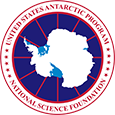|
Antarctic Dinosaur Extends its Range into Ohio 
National Science Foundation Posted September 24, 2018 Image: The Ohio State University The fossil remains of Cryolophosaurus-—"frozen crest lizard”—ellioti were the first of a carnivorous dinosaur to be discovered in #Antarctica and the first non-avian dinosaur from the continent to be officially named. The sediments in which its fossils were found were laid down in the Early Jurassic Period. Now, a full-sized replica of the dinosaur’s skeleton is on display at The Ohio State University's Orton Geological Museum. Read more about the new exhibit in an Ohio State news release here: https://artsandsciences.osu.edu/news/dinosaur-orton-0 Cryolophosaurus’ bones were uncovered in 1990–91 Southern Hemisphere summer on Mount Kirkpatrick in the Beardmore Glacier region of the Transantarctic Mountains, when Ohio State faculty member David Elliot tracking volcanic ash deposits with the Byrd Polar and Climate Research Center . Elliot came across the massive dinosaur bones, encased in rock and ice. Research teams led by Augustana College - Illinois researcher William Hammer and Elliot were working on separate outcroppings, sharing logistical expenses. Elliot notified Hammer’s team of the find. Hammer excavated and categorize the specimen. The creature was formally named, after Elliot, and described in 1994 by Hammer and a colleague William J. Hickerson, in the journal Science. But NSF continued to support additional #research to put the dinosaur into a historical and ecological context, including with this award: https://www.nsf.gov/awardsearch/showAward?AWD_ID=1244253 / Collaborative Research: Continued Research on the Jurassic Vertebrate Fauna from the Beardmore Glacier Region of Antarctica
|



For USAP Participants |
For The Public |
For Researchers and EducatorsContact UsU.S. National Science FoundationOffice of Polar Programs Geosciences Directorate 2415 Eisenhower Avenue, Suite W7100 Alexandria, VA 22314 Sign up for the NSF Office of Polar Programs newsletter and events. Feedback Form |

